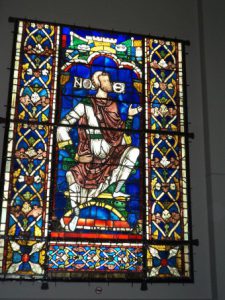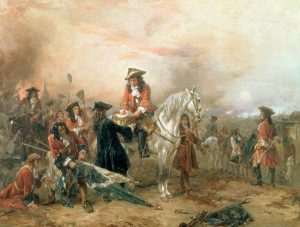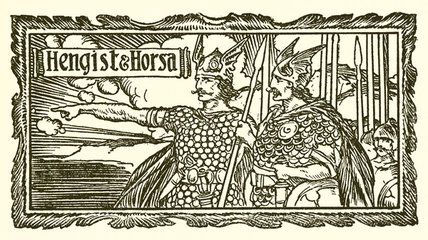This week I want to draw your attention to a few of the lectures that will be taking place at the Tudors and Stuarts History Weekend on Saturday 13th and Sunday 14th April. For full details see: www.canterbury.ac.uk/tudors-stuarts but before that yesterday was our Kent History postgraduates meeting, the presentations given by Dean Irwin and then Lily Hawker-Yates.
As frequent readers of the blog will know, Dean is working on the middle tier of the English Jewry until their expulsion under Edward I. In the past we have heard about the commercial lives of these prosperous Jews, with special reference to Canterbury. However this time he turned his attention to the scribes, who not only worked on documents for the Archa in the city ie writing the chirographs and other deeds that recorded in duplicate all the transactions the Jews were involved in – one copy to the Jewish creditor, the other kept in the Archa, with a third copy recorded on a roll available for scrutiny at Westminster, but who were involved as civic scribes – town government, but probably also as professional writer for anyone who required their services – charters, leases and other documents involving land and other transactions. To a degree, this followed Mary Berg’s Canterbury Historical and Archaeological Society [CHAS] lecture on one of the early charters in the city’s collection that she thinks has a depiction of the first medieval Westgate [pre-Sudbury and the extant Westgate Towers], because Dean and Mary both became interested in identifying, if at all possible, the scribe who drew up this charter. As Dean said, this led to a very enjoyable afternoon in Canterbury Cathedral Archives where the two of them were looking at the scribal hands, the names of witnesses, autographs, and any useful references in the text, such as ‘I Roger the clerk …’. As a result, and further work by Dean, including comparing hands etc in the Westminster records, he is now getting together a chronological chart of the Canterbury scribes who were working across the 13th century on civic, Archa and other records in the city. Among these men were Roger the clerk (of Westgate) who replaced Thomas Man (active for 9 years 5 months), Roger instrumental in the writing of 20 to 25 charters for his English clients, as well as his work for the Archa.

Noah, one of Christ’s Jewish ancestors – Canterbury Cathedral
As mentioned in previous blogs, the importance of a scribal culture, as well as the earlier use of innovative practices among the Jewish record makers, perhaps half a century before those in royal government, is an important development in the 13th century, with further developments in the later Middle Ages. Some of these were discussed by Professor Michael Clanchy in his From Memory to Written Record (1st published 1979), but these ideas continue to be refined and tested, and it was very interesting to see Dean’s findings.
Turning to Lily’s presentation, she took us on an ‘expedition’ to Conisborough Castle in Yorkshire courtesy of Geoffrey of Monmouth’s identification of the barrow near the castle as being the burial place of Hengist, better known for his activities in post-Roman Kent. For Geoffrey seems to have been the first to note the burial in the surviving sources, and this identification was then picked up by others, including Camden among the early modern antiquarians. Lily also traced back in the sources pre-Geoffrey what is said about Hengist, as well as what is known about Horsa his companion in these same texts, such as versions of the Anglo-Saxon Chronicle.

Hengist and Horsa in Edward Parrott’s Pageant of British History (1909)
https://en.wikipedia.org/wiki/Hengist_and_Horsa#/media/File:Hengist_and_Horsa.jpg
Having sketched out these various narratives about the period after the Roman legions left England as they cover Vortigern’s invitation to Hengist and his followers to help him keep out the Saxons, Hengist’s activities on his own behalf and ultimately his treachery towards Vortigern and the Britons, the battle between Hengist and the Britons’ saviour King Aurelius that led to Hengist’s defeat and death as a traitor, Lily came back to the particularity of Geoffrey’s description. For he seems to have been very specific that Hengist was buried under a heap of earth (an idea not followed by his successors), as well as identifying a real place in the landscape and presumably that barrows were to be identified as pagan burials. Lily is still exploring these issues, but, as she said, it is feasible to see this narrative as outlining significant parallels to its Anglo-Norman audience using biblical and recent historical persons. This using of types was a common aspect of medieval theological practice and was equally understood to be applicable respecting more recent historical people. Thus, as one set of types we have the biblical King Agag, Harold the last Saxon king and Hengist; with the opposite set of ‘good’ types being the prophet Samuel, William the Conqueror and Vorigern or more probably Aurelius. Moreover, such typology can also be linked to Conisborough Castle itself, having been part of Harold’s possessions which came into the hands of William, who gave it to his son-in-law. Such a use of this barrow within the landscape at one time part of the Danelaw and ravaged by William I in his ‘harrying of the north’ seems to draw on several cultural and perhaps ethnic ideas of civilization and barbarism, as well as Christianity and paganism. Like Dean’s presentation, Lily’s similarly sparked a lively discussion among the other postgraduates, another good session!
I thought I would take three of Lily’s themes of kingship, war and treachery to briefly mention lectures at the Tudors and Stuarts History Weekend that would be appropriate. So, if you are interested in king (and queens) we have some treats for you. Working chronologically through the period, Dr David Starkey (Saturday 6pm) will be exploring just how Henry VII organised the royal finances, perhaps especially appropriate at this time of budget cuts! Moving on to his son’s reign, Amy Licence (Sunday midday) will examine the European influences on Anne Boleyn and how these shaped her appearance and ideas. Keeping with Henry VIII’s wives, Alison Weir (Saturday 11.30am) will discuss the history behind the fiction of Anna of Kleve. Moving on to Anne Boleyn’s daughter, Queen Elizabeth I will be the subject of Dr Helen Castor’s (Saturday 1.30pm) lecture, where she will investigate how her reign ‘was shaped by profound and enduring insecurity.’ On into the Stuarts, Professor Kenneth Fincham (Sunday 10.30am) will assess how involved King James I was in the creation of the Bible that carries his name, while if it is the royal court that sounds exciting, Professor Maria Hayward (Saturday 11.30am) will explore the myriad ways perfume was employed at royal courts throughout the 16th and 17th centuries. Even if he isn’t royal, he was certainly a ruler, and intriguingly Dr Clive Holmes (Sunday 2pm) will take a look at Oliver Cromwell through the idea of why he didn’t persecute witches.

‘Duke of Marlborough signing the Despatch at Blenheim’ (oil on canvas) by Robert Alexander Hillingford (1825-1904) https://en.wikipedia.org/wiki/Battle_of_Blenheim#/media/File:Duke-of-Marlborough-signing-Despatch-Blenheim-Bavaria-1704.jpg
In some ways this may link nicely to war, and, if that looks interesting, we have more great lectures. Dr David Grummitt (Sunday 10.30am) investigates the military garrison of Calais, as well as its other roles in this part of early Tudor England. Professor Andrew Hopper (Saturday 3pm) will take us to the human cost of war, specifically in terms of the English Civil War, while Professor Keith McLay (Saturday 1.30pm) will examine the very interesting life of the man who was victorious at Blenheim.
As Lily saw through her narratives, treachery can lead to devastating circumstances, and Dr Astrid Stilma (Saturday 10am) will explore just how close the British Isles came to grief through the several plots, conspiracies and rebellions that governments battled in the early years of the 17th century. For, even though Guy Fawkes and his cronies are well known, they were but one part of a much bigger story.
Just as a postscript, the ‘Finding Eanswythe’ project is due to have an exhibition in Folkestone Library in February, involving Drs Lesley Hardy and Ellie Williams from CCCU, and Andrew Richardson from Canterbury Archaeological Trust. While on the north Kent coast, Dr Martin Watts is working with Whitstable Maritime on a Heritage Lottery Fund bid that will focus on the restoration of ‘The Gamecock’, now designated a Historic Ship, being the last of the Whitstable oyster yawls.
 Centre for Kent History and Heritage
Centre for Kent History and Heritage Sheila Sweetinburgh
Sheila Sweetinburgh 995
995


